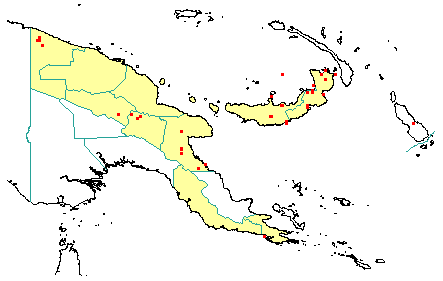
in PNGplants database
PNGTreesKey – Eucalyptus deglupta Blume |
Barry Conn (NSW) & Kipiro Damas (LAE).
Guide to trees of Papua New Guinea
Copyright held by the authors, National Herbarium of New South Wales, and Papua New Guinea National Herbarium
Museum Botanicum Lugduno-Batavum sive stirpium Exoticarum, Novarum vel Minus Cognitarum ex Vivis aut Siccis Brevis Expositio et Descriptio Vol. 1: 83 (1850)
Family: Myrtaceae
Dicotyledon
Timber Group: Major exportable hardwood or Plantation species Tradename: Kamarere
Field Characters: Emergent tree (occasionally up to 60 m high) or Large canopy tree (up to 30 m high); Bole cylindrical (to slightly fluted, up to c. 150 cm diam., rarely larger) or markedly fluted; straight (bole up to c. 30 m lomg); buttresses buttresses absent or buttresses present (sometimes buttresses up to 3-4 m high); spines spines absent; aerial roots aerial roots absent; stilt roots stilt roots absent; Bark yellow, green, pale red, bluish grey, or brown (multi-coloured), slightly rough or smooth, peeling (slightly (bark green-coloured after peeling); Subrhytidome (under-bark) green; less than 25 mm thick (5 mm), 5.0-8.0; bark blaze consisting of one layer; faintly to non-aromatic; outer blaze white (cream-coloured) or slightly pink, markings absent, fibrous; inner blaze white (cream-coloured) or slightly pink, markings absent, fibrous; bark exudate (sap) present, colourless, not readily flowing (spotty), colour not changing on exposure to air or colour changing on exposure to air, to purple (on contact with metal), not sticky; terminal buds not enclosed by leaves.
Indumentum: Complex hairs absent; stinging hairs absent; mature twig indumentum (hairs) absent.
Leaves: Leaves spaced along branches, spiral (leaves occurring singly at a node and arranged spirally up the branchlet) or sub opposite (in pairs, opposite one another on the branchlet), simple (a leaf composed of a single blade); petiole present, not winged, attached to base of leaf blade, swollen (slightly broader at tip, gradually tapering from tip, at base of lamina, to petiole base); leaves broadest below middle, 7.5-15.0 (-20.0) cm, 5.0-8.0 (-10.0) cm; symmetric, entire, not dissected or lobed, acuminate or slightly long-tapering, venation pinnate, secondary veins open, not prominent, but visible, intramarginal veins absent; leaves lower surface green, upper surface green (glossy), indumentum (hairs) absent; present; domatia absent; stipules absent.
Flowers: Inflorescence terminal or axillary (in distal leaf axils), flowers on a branched axis, cones absent; flowers bisexual, stalked, flowers with many planes of symmetry, 5.0-8.0 mm long, diameter small (up to10 mm diam.) (5-7 mm diam.); perianth absent (by misinterpretation (perianth fused into a cap/operculum) or present, with all sepals and/or petals (hence tepals) similar (as a cap/operculum), inner perianth green (cap/operculum); 0, all joined (and dehiscing as a cap/operculum); stamens 100, present (pale yellow to cream-coloured), free of each other, free of the perianth (joined to hypanthium); ovary inferior, carpels joined (when more than one), locules 3-4; styles solitary, 1.
Fruits: Infrutescence arranged on branched axis, fruit 3.0-5.0 mm long, 3.0-5.0 mm diam., dark brown or green (dark (immature), not spiny, non-fleshy, simple, dehiscent, capsule (3-4-valved, valves up to 2 mm exserted); seeds 12-(c.; c. (well-formed seeds)-50, barely visible (to 1 mm long), winged (slightly (with a small terminal wing), narrow (longer than wide), seed less than 1 mm diam.
Distribution: West Sepik, East Sepik, Madang, Morobe (Cultivated), Western Highlands, Eastern Highlands, Central, Milne Bay & New Britain.
 | Botanical records in PNGplants database |